Human Resource Development in Action: ALDI Training Report
VerifiedAdded on 2020/05/16
|23
|6507
|52
Report
AI Summary
This report provides a comprehensive analysis of a Human Resource Development (HRD) training program designed for ALDI. It begins by exploring various learning styles, including Activists, Pragmatists, Theorists, and Reflectors, and discusses their relevance to employee training. The report then delves into the significance of the learning curve and learning transfer within ALDI's context, emphasizing the importance of knowledge sharing. Furthermore, it examines the application of different learning theories, such as Honey & Mumford, Myer Briggs, and Kolb’s theory, in the development of effective training events. The analysis extends to assessing staff learning requirements across different departments within ALDI, outlining specific training needs for administrative, consumer service, and operations divisions. The report also evaluates the merits and drawbacks of various training methods, including coaching, performance appraisal, and workshops. A systematic approach to planning a training event for ALDI is presented, detailing program objectives, design criteria, and implementation steps. Finally, the report includes the preparation of an evaluation form to analyze employee learning outcomes, examines the responses received, and reviews the overall effectiveness of the training program.
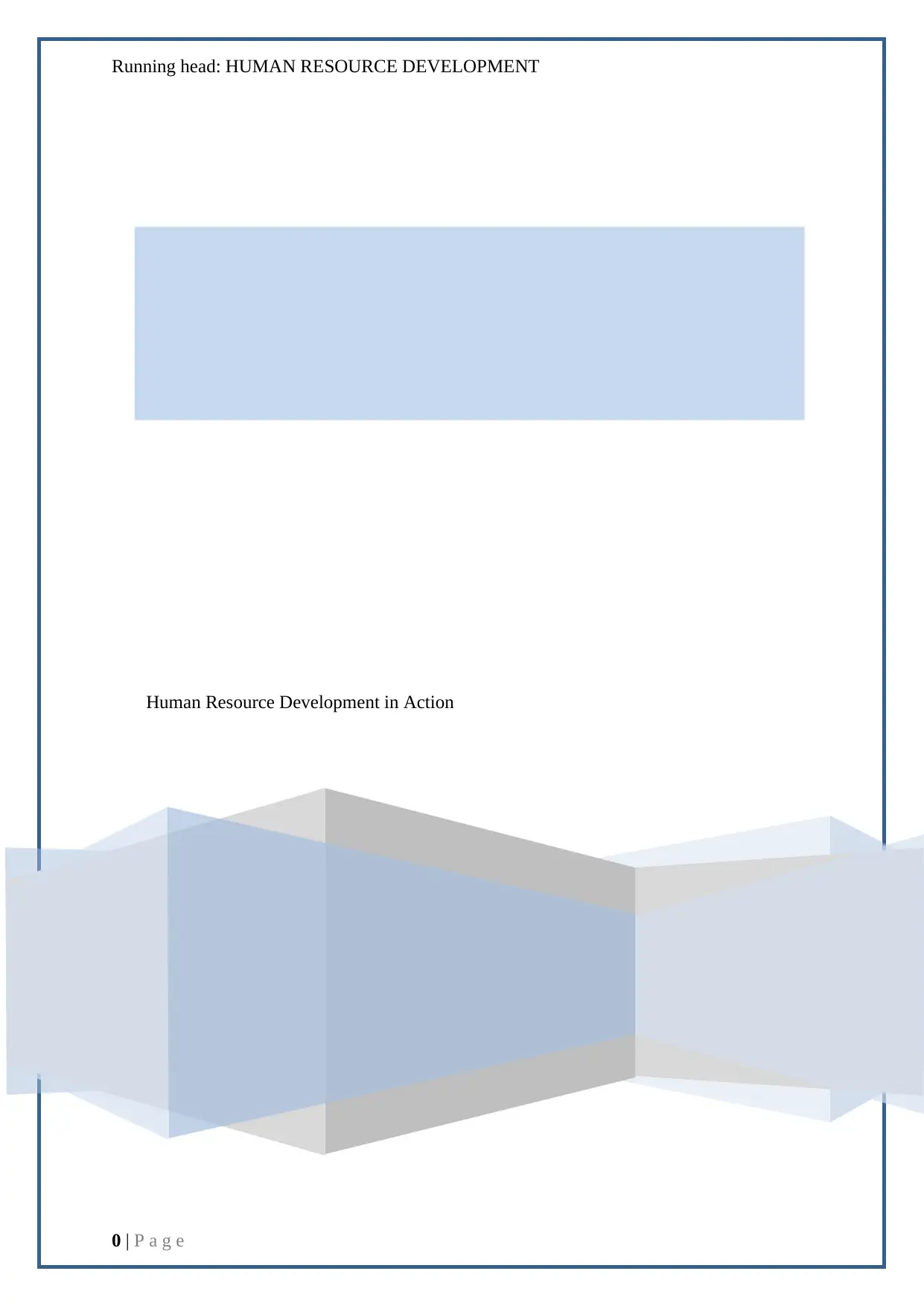
Running head: HUMAN RESOURCE DEVELOPMENT
0 | P a g e
Human Resource Development in Action
0 | P a g e
Human Resource Development in Action
Paraphrase This Document
Need a fresh take? Get an instant paraphrase of this document with our AI Paraphraser
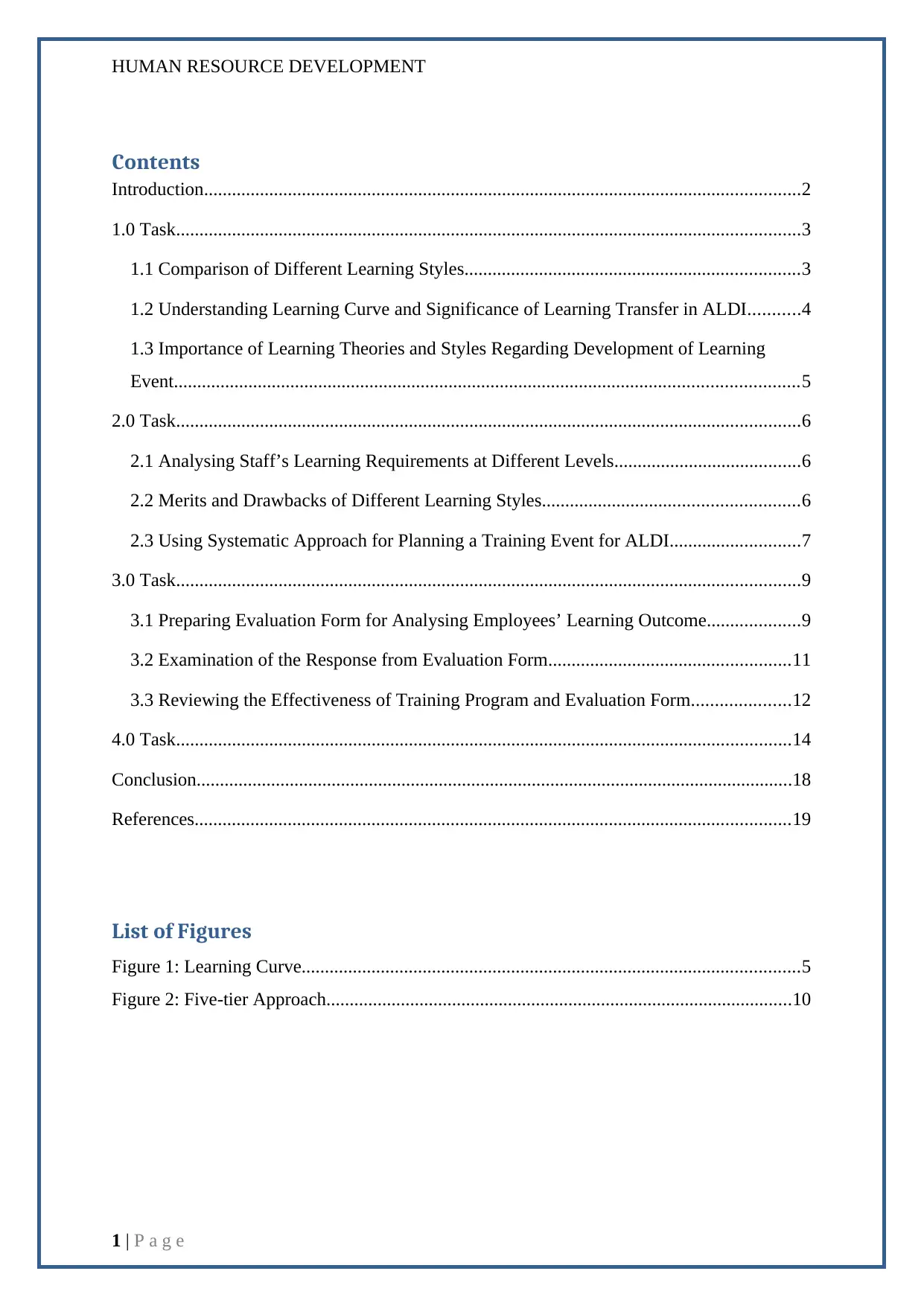
HUMAN RESOURCE DEVELOPMENT
Contents
Introduction................................................................................................................................2
1.0 Task......................................................................................................................................3
1.1 Comparison of Different Learning Styles........................................................................3
1.2 Understanding Learning Curve and Significance of Learning Transfer in ALDI...........4
1.3 Importance of Learning Theories and Styles Regarding Development of Learning
Event......................................................................................................................................5
2.0 Task......................................................................................................................................6
2.1 Analysing Staff’s Learning Requirements at Different Levels........................................6
2.2 Merits and Drawbacks of Different Learning Styles.......................................................6
2.3 Using Systematic Approach for Planning a Training Event for ALDI............................7
3.0 Task......................................................................................................................................9
3.1 Preparing Evaluation Form for Analysing Employees’ Learning Outcome....................9
3.2 Examination of the Response from Evaluation Form....................................................11
3.3 Reviewing the Effectiveness of Training Program and Evaluation Form.....................12
4.0 Task....................................................................................................................................14
Conclusion................................................................................................................................18
References................................................................................................................................19
List of Figures
Figure 1: Learning Curve...........................................................................................................5
Figure 2: Five-tier Approach....................................................................................................10
1 | P a g e
Contents
Introduction................................................................................................................................2
1.0 Task......................................................................................................................................3
1.1 Comparison of Different Learning Styles........................................................................3
1.2 Understanding Learning Curve and Significance of Learning Transfer in ALDI...........4
1.3 Importance of Learning Theories and Styles Regarding Development of Learning
Event......................................................................................................................................5
2.0 Task......................................................................................................................................6
2.1 Analysing Staff’s Learning Requirements at Different Levels........................................6
2.2 Merits and Drawbacks of Different Learning Styles.......................................................6
2.3 Using Systematic Approach for Planning a Training Event for ALDI............................7
3.0 Task......................................................................................................................................9
3.1 Preparing Evaluation Form for Analysing Employees’ Learning Outcome....................9
3.2 Examination of the Response from Evaluation Form....................................................11
3.3 Reviewing the Effectiveness of Training Program and Evaluation Form.....................12
4.0 Task....................................................................................................................................14
Conclusion................................................................................................................................18
References................................................................................................................................19
List of Figures
Figure 1: Learning Curve...........................................................................................................5
Figure 2: Five-tier Approach....................................................................................................10
1 | P a g e
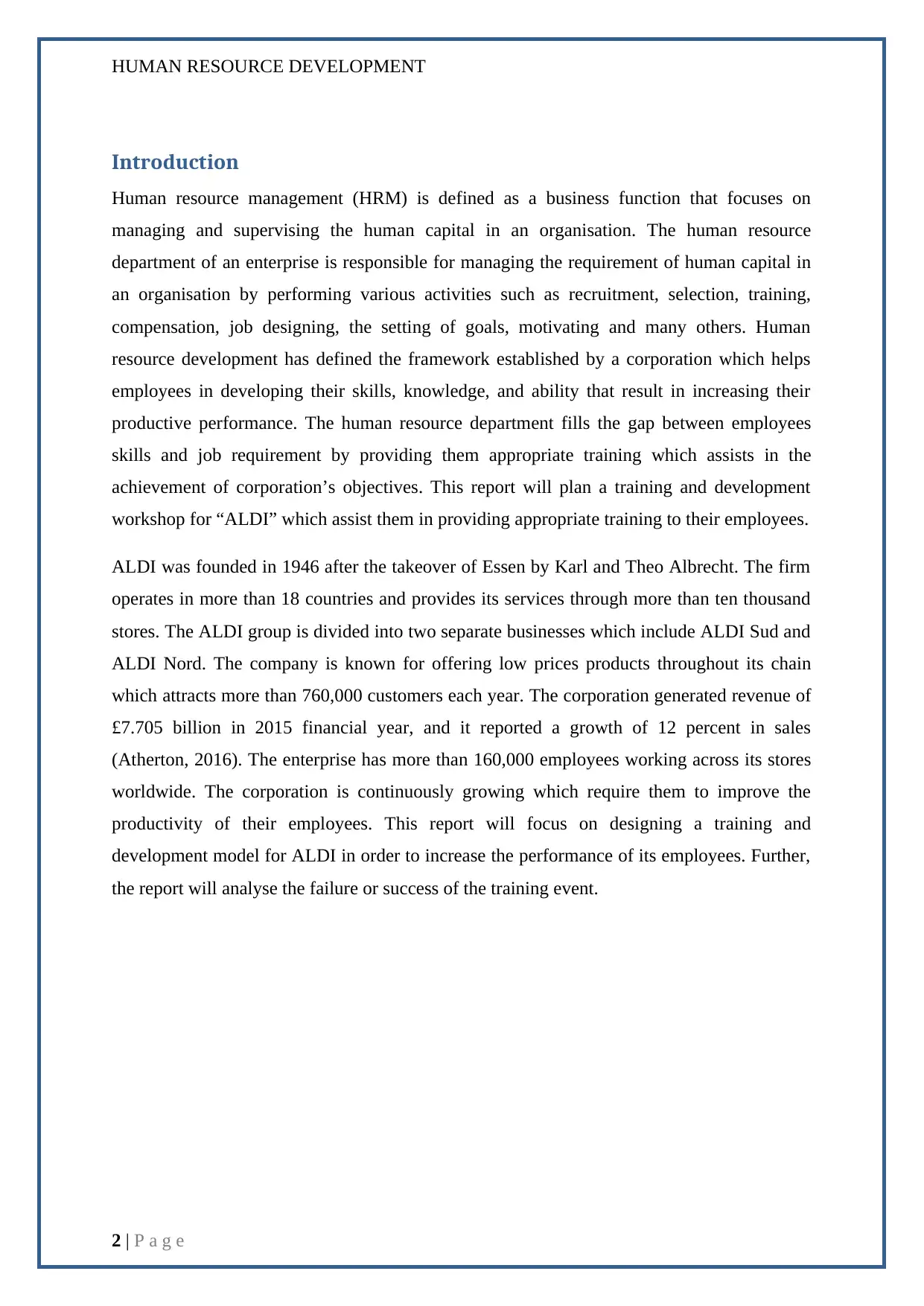
HUMAN RESOURCE DEVELOPMENT
Introduction
Human resource management (HRM) is defined as a business function that focuses on
managing and supervising the human capital in an organisation. The human resource
department of an enterprise is responsible for managing the requirement of human capital in
an organisation by performing various activities such as recruitment, selection, training,
compensation, job designing, the setting of goals, motivating and many others. Human
resource development has defined the framework established by a corporation which helps
employees in developing their skills, knowledge, and ability that result in increasing their
productive performance. The human resource department fills the gap between employees
skills and job requirement by providing them appropriate training which assists in the
achievement of corporation’s objectives. This report will plan a training and development
workshop for “ALDI” which assist them in providing appropriate training to their employees.
ALDI was founded in 1946 after the takeover of Essen by Karl and Theo Albrecht. The firm
operates in more than 18 countries and provides its services through more than ten thousand
stores. The ALDI group is divided into two separate businesses which include ALDI Sud and
ALDI Nord. The company is known for offering low prices products throughout its chain
which attracts more than 760,000 customers each year. The corporation generated revenue of
£7.705 billion in 2015 financial year, and it reported a growth of 12 percent in sales
(Atherton, 2016). The enterprise has more than 160,000 employees working across its stores
worldwide. The corporation is continuously growing which require them to improve the
productivity of their employees. This report will focus on designing a training and
development model for ALDI in order to increase the performance of its employees. Further,
the report will analyse the failure or success of the training event.
2 | P a g e
Introduction
Human resource management (HRM) is defined as a business function that focuses on
managing and supervising the human capital in an organisation. The human resource
department of an enterprise is responsible for managing the requirement of human capital in
an organisation by performing various activities such as recruitment, selection, training,
compensation, job designing, the setting of goals, motivating and many others. Human
resource development has defined the framework established by a corporation which helps
employees in developing their skills, knowledge, and ability that result in increasing their
productive performance. The human resource department fills the gap between employees
skills and job requirement by providing them appropriate training which assists in the
achievement of corporation’s objectives. This report will plan a training and development
workshop for “ALDI” which assist them in providing appropriate training to their employees.
ALDI was founded in 1946 after the takeover of Essen by Karl and Theo Albrecht. The firm
operates in more than 18 countries and provides its services through more than ten thousand
stores. The ALDI group is divided into two separate businesses which include ALDI Sud and
ALDI Nord. The company is known for offering low prices products throughout its chain
which attracts more than 760,000 customers each year. The corporation generated revenue of
£7.705 billion in 2015 financial year, and it reported a growth of 12 percent in sales
(Atherton, 2016). The enterprise has more than 160,000 employees working across its stores
worldwide. The corporation is continuously growing which require them to improve the
productivity of their employees. This report will focus on designing a training and
development model for ALDI in order to increase the performance of its employees. Further,
the report will analyse the failure or success of the training event.
2 | P a g e
⊘ This is a preview!⊘
Do you want full access?
Subscribe today to unlock all pages.

Trusted by 1+ million students worldwide
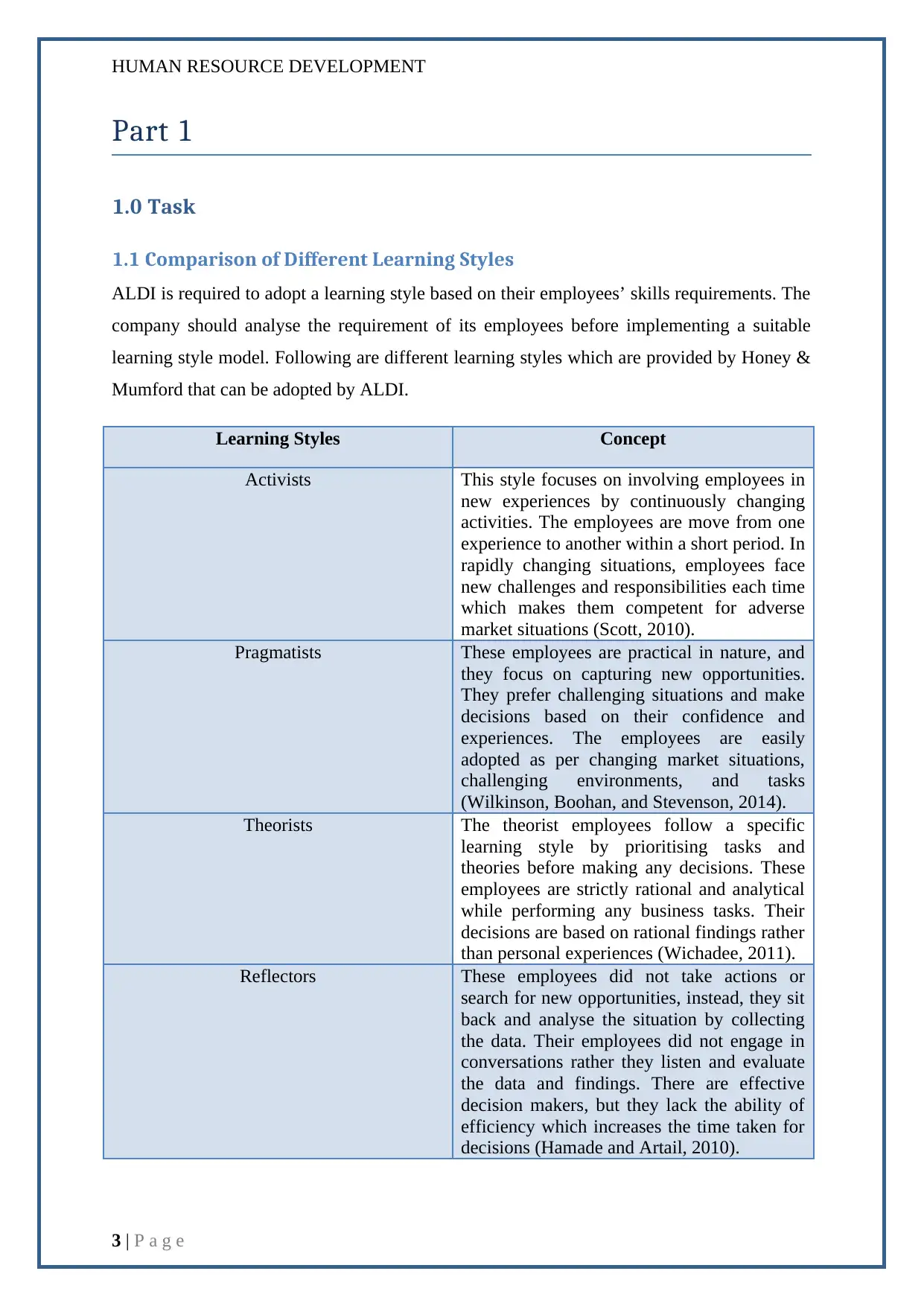
HUMAN RESOURCE DEVELOPMENT
Part 1
1.0 Task
1.1 Comparison of Different Learning Styles
ALDI is required to adopt a learning style based on their employees’ skills requirements. The
company should analyse the requirement of its employees before implementing a suitable
learning style model. Following are different learning styles which are provided by Honey &
Mumford that can be adopted by ALDI.
Learning Styles Concept
Activists This style focuses on involving employees in
new experiences by continuously changing
activities. The employees are move from one
experience to another within a short period. In
rapidly changing situations, employees face
new challenges and responsibilities each time
which makes them competent for adverse
market situations (Scott, 2010).
Pragmatists These employees are practical in nature, and
they focus on capturing new opportunities.
They prefer challenging situations and make
decisions based on their confidence and
experiences. The employees are easily
adopted as per changing market situations,
challenging environments, and tasks
(Wilkinson, Boohan, and Stevenson, 2014).
Theorists The theorist employees follow a specific
learning style by prioritising tasks and
theories before making any decisions. These
employees are strictly rational and analytical
while performing any business tasks. Their
decisions are based on rational findings rather
than personal experiences (Wichadee, 2011).
Reflectors These employees did not take actions or
search for new opportunities, instead, they sit
back and analyse the situation by collecting
the data. Their employees did not engage in
conversations rather they listen and evaluate
the data and findings. There are effective
decision makers, but they lack the ability of
efficiency which increases the time taken for
decisions (Hamade and Artail, 2010).
3 | P a g e
Part 1
1.0 Task
1.1 Comparison of Different Learning Styles
ALDI is required to adopt a learning style based on their employees’ skills requirements. The
company should analyse the requirement of its employees before implementing a suitable
learning style model. Following are different learning styles which are provided by Honey &
Mumford that can be adopted by ALDI.
Learning Styles Concept
Activists This style focuses on involving employees in
new experiences by continuously changing
activities. The employees are move from one
experience to another within a short period. In
rapidly changing situations, employees face
new challenges and responsibilities each time
which makes them competent for adverse
market situations (Scott, 2010).
Pragmatists These employees are practical in nature, and
they focus on capturing new opportunities.
They prefer challenging situations and make
decisions based on their confidence and
experiences. The employees are easily
adopted as per changing market situations,
challenging environments, and tasks
(Wilkinson, Boohan, and Stevenson, 2014).
Theorists The theorist employees follow a specific
learning style by prioritising tasks and
theories before making any decisions. These
employees are strictly rational and analytical
while performing any business tasks. Their
decisions are based on rational findings rather
than personal experiences (Wichadee, 2011).
Reflectors These employees did not take actions or
search for new opportunities, instead, they sit
back and analyse the situation by collecting
the data. Their employees did not engage in
conversations rather they listen and evaluate
the data and findings. There are effective
decision makers, but they lack the ability of
efficiency which increases the time taken for
decisions (Hamade and Artail, 2010).
3 | P a g e
Paraphrase This Document
Need a fresh take? Get an instant paraphrase of this document with our AI Paraphraser
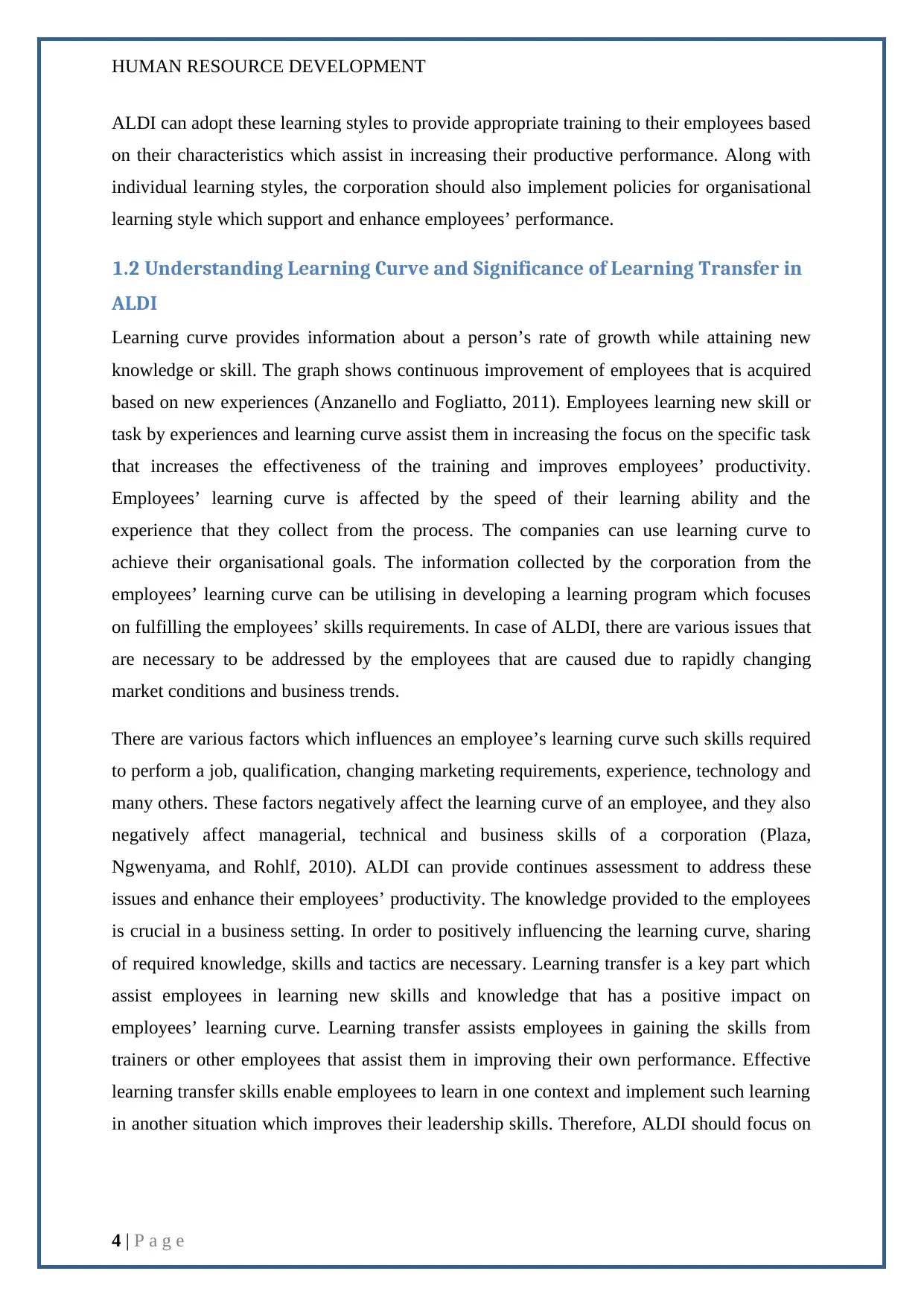
HUMAN RESOURCE DEVELOPMENT
ALDI can adopt these learning styles to provide appropriate training to their employees based
on their characteristics which assist in increasing their productive performance. Along with
individual learning styles, the corporation should also implement policies for organisational
learning style which support and enhance employees’ performance.
1.2 Understanding Learning Curve and Significance of Learning Transfer in
ALDI
Learning curve provides information about a person’s rate of growth while attaining new
knowledge or skill. The graph shows continuous improvement of employees that is acquired
based on new experiences (Anzanello and Fogliatto, 2011). Employees learning new skill or
task by experiences and learning curve assist them in increasing the focus on the specific task
that increases the effectiveness of the training and improves employees’ productivity.
Employees’ learning curve is affected by the speed of their learning ability and the
experience that they collect from the process. The companies can use learning curve to
achieve their organisational goals. The information collected by the corporation from the
employees’ learning curve can be utilising in developing a learning program which focuses
on fulfilling the employees’ skills requirements. In case of ALDI, there are various issues that
are necessary to be addressed by the employees that are caused due to rapidly changing
market conditions and business trends.
There are various factors which influences an employee’s learning curve such skills required
to perform a job, qualification, changing marketing requirements, experience, technology and
many others. These factors negatively affect the learning curve of an employee, and they also
negatively affect managerial, technical and business skills of a corporation (Plaza,
Ngwenyama, and Rohlf, 2010). ALDI can provide continues assessment to address these
issues and enhance their employees’ productivity. The knowledge provided to the employees
is crucial in a business setting. In order to positively influencing the learning curve, sharing
of required knowledge, skills and tactics are necessary. Learning transfer is a key part which
assist employees in learning new skills and knowledge that has a positive impact on
employees’ learning curve. Learning transfer assists employees in gaining the skills from
trainers or other employees that assist them in improving their own performance. Effective
learning transfer skills enable employees to learn in one context and implement such learning
in another situation which improves their leadership skills. Therefore, ALDI should focus on
4 | P a g e
ALDI can adopt these learning styles to provide appropriate training to their employees based
on their characteristics which assist in increasing their productive performance. Along with
individual learning styles, the corporation should also implement policies for organisational
learning style which support and enhance employees’ performance.
1.2 Understanding Learning Curve and Significance of Learning Transfer in
ALDI
Learning curve provides information about a person’s rate of growth while attaining new
knowledge or skill. The graph shows continuous improvement of employees that is acquired
based on new experiences (Anzanello and Fogliatto, 2011). Employees learning new skill or
task by experiences and learning curve assist them in increasing the focus on the specific task
that increases the effectiveness of the training and improves employees’ productivity.
Employees’ learning curve is affected by the speed of their learning ability and the
experience that they collect from the process. The companies can use learning curve to
achieve their organisational goals. The information collected by the corporation from the
employees’ learning curve can be utilising in developing a learning program which focuses
on fulfilling the employees’ skills requirements. In case of ALDI, there are various issues that
are necessary to be addressed by the employees that are caused due to rapidly changing
market conditions and business trends.
There are various factors which influences an employee’s learning curve such skills required
to perform a job, qualification, changing marketing requirements, experience, technology and
many others. These factors negatively affect the learning curve of an employee, and they also
negatively affect managerial, technical and business skills of a corporation (Plaza,
Ngwenyama, and Rohlf, 2010). ALDI can provide continues assessment to address these
issues and enhance their employees’ productivity. The knowledge provided to the employees
is crucial in a business setting. In order to positively influencing the learning curve, sharing
of required knowledge, skills and tactics are necessary. Learning transfer is a key part which
assist employees in learning new skills and knowledge that has a positive impact on
employees’ learning curve. Learning transfer assists employees in gaining the skills from
trainers or other employees that assist them in improving their own performance. Effective
learning transfer skills enable employees to learn in one context and implement such learning
in another situation which improves their leadership skills. Therefore, ALDI should focus on
4 | P a g e
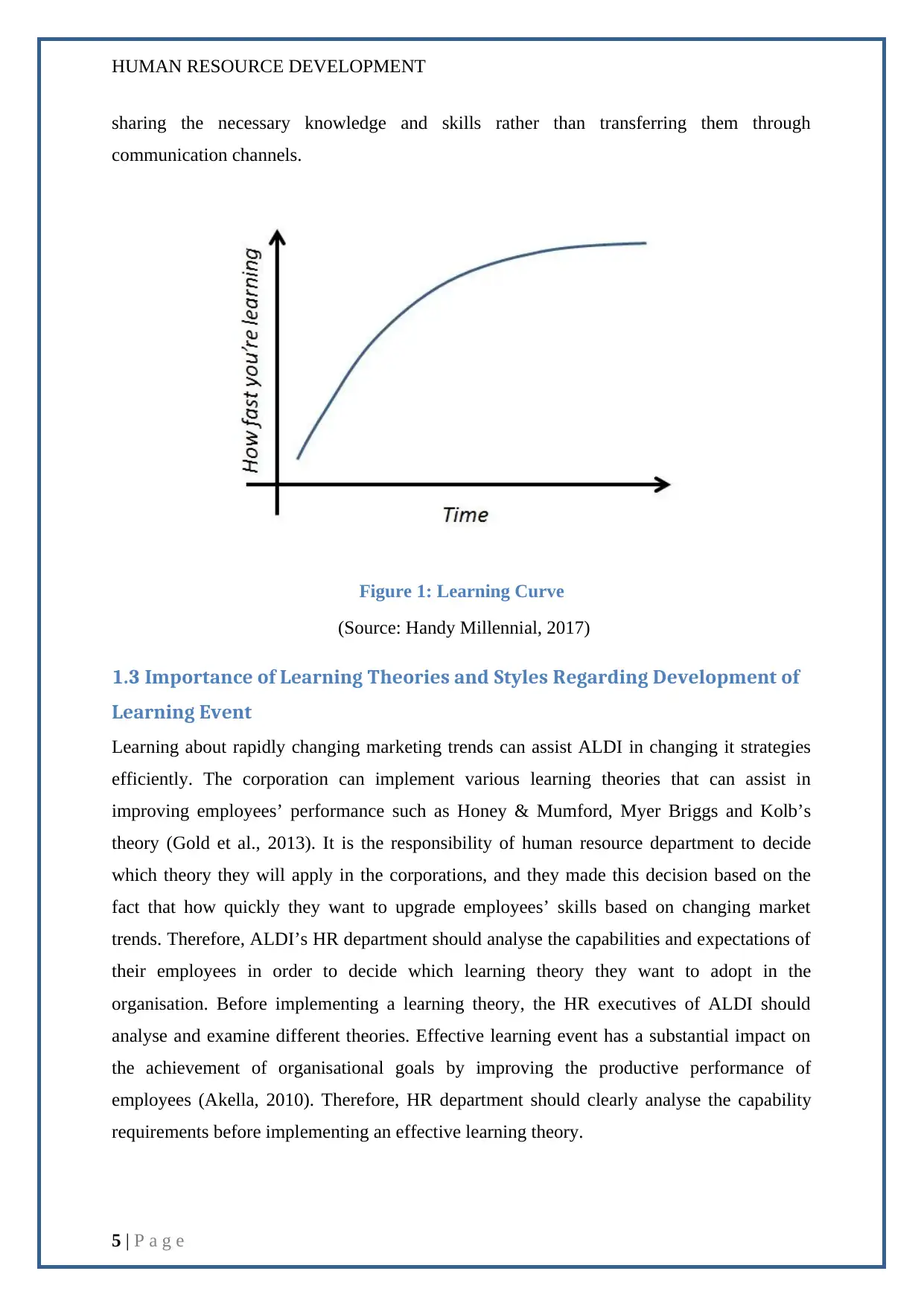
HUMAN RESOURCE DEVELOPMENT
sharing the necessary knowledge and skills rather than transferring them through
communication channels.
Figure 1: Learning Curve
(Source: Handy Millennial, 2017)
1.3 Importance of Learning Theories and Styles Regarding Development of
Learning Event
Learning about rapidly changing marketing trends can assist ALDI in changing it strategies
efficiently. The corporation can implement various learning theories that can assist in
improving employees’ performance such as Honey & Mumford, Myer Briggs and Kolb’s
theory (Gold et al., 2013). It is the responsibility of human resource department to decide
which theory they will apply in the corporations, and they made this decision based on the
fact that how quickly they want to upgrade employees’ skills based on changing market
trends. Therefore, ALDI’s HR department should analyse the capabilities and expectations of
their employees in order to decide which learning theory they want to adopt in the
organisation. Before implementing a learning theory, the HR executives of ALDI should
analyse and examine different theories. Effective learning event has a substantial impact on
the achievement of organisational goals by improving the productive performance of
employees (Akella, 2010). Therefore, HR department should clearly analyse the capability
requirements before implementing an effective learning theory.
5 | P a g e
sharing the necessary knowledge and skills rather than transferring them through
communication channels.
Figure 1: Learning Curve
(Source: Handy Millennial, 2017)
1.3 Importance of Learning Theories and Styles Regarding Development of
Learning Event
Learning about rapidly changing marketing trends can assist ALDI in changing it strategies
efficiently. The corporation can implement various learning theories that can assist in
improving employees’ performance such as Honey & Mumford, Myer Briggs and Kolb’s
theory (Gold et al., 2013). It is the responsibility of human resource department to decide
which theory they will apply in the corporations, and they made this decision based on the
fact that how quickly they want to upgrade employees’ skills based on changing market
trends. Therefore, ALDI’s HR department should analyse the capabilities and expectations of
their employees in order to decide which learning theory they want to adopt in the
organisation. Before implementing a learning theory, the HR executives of ALDI should
analyse and examine different theories. Effective learning event has a substantial impact on
the achievement of organisational goals by improving the productive performance of
employees (Akella, 2010). Therefore, HR department should clearly analyse the capability
requirements before implementing an effective learning theory.
5 | P a g e
⊘ This is a preview!⊘
Do you want full access?
Subscribe today to unlock all pages.

Trusted by 1+ million students worldwide
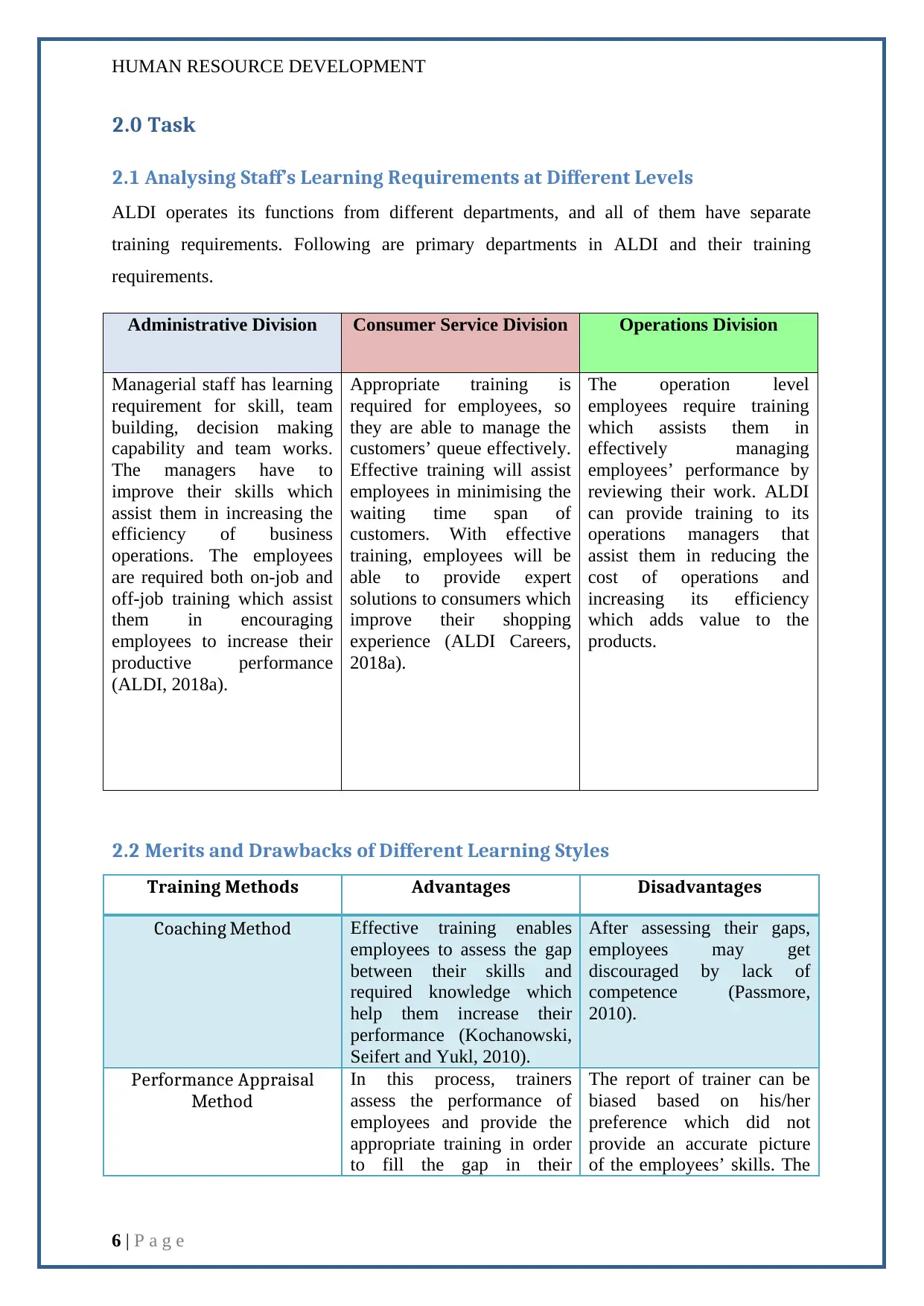
HUMAN RESOURCE DEVELOPMENT
2.0 Task
2.1 Analysing Staff’s Learning Requirements at Different Levels
ALDI operates its functions from different departments, and all of them have separate
training requirements. Following are primary departments in ALDI and their training
requirements.
Administrative Division Consumer Service Division Operations Division
Managerial staff has learning
requirement for skill, team
building, decision making
capability and team works.
The managers have to
improve their skills which
assist them in increasing the
efficiency of business
operations. The employees
are required both on-job and
off-job training which assist
them in encouraging
employees to increase their
productive performance
(ALDI, 2018a).
Appropriate training is
required for employees, so
they are able to manage the
customers’ queue effectively.
Effective training will assist
employees in minimising the
waiting time span of
customers. With effective
training, employees will be
able to provide expert
solutions to consumers which
improve their shopping
experience (ALDI Careers,
2018a).
The operation level
employees require training
which assists them in
effectively managing
employees’ performance by
reviewing their work. ALDI
can provide training to its
operations managers that
assist them in reducing the
cost of operations and
increasing its efficiency
which adds value to the
products.
2.2 Merits and Drawbacks of Different Learning Styles
Training Methods Advantages Disadvantages
Coaching Method Effective training enables
employees to assess the gap
between their skills and
required knowledge which
help them increase their
performance (Kochanowski,
Seifert and Yukl, 2010).
After assessing their gaps,
employees may get
discouraged by lack of
competence (Passmore,
2010).
Performance Appraisal
Method
In this process, trainers
assess the performance of
employees and provide the
appropriate training in order
to fill the gap in their
The report of trainer can be
biased based on his/her
preference which did not
provide an accurate picture
of the employees’ skills. The
6 | P a g e
2.0 Task
2.1 Analysing Staff’s Learning Requirements at Different Levels
ALDI operates its functions from different departments, and all of them have separate
training requirements. Following are primary departments in ALDI and their training
requirements.
Administrative Division Consumer Service Division Operations Division
Managerial staff has learning
requirement for skill, team
building, decision making
capability and team works.
The managers have to
improve their skills which
assist them in increasing the
efficiency of business
operations. The employees
are required both on-job and
off-job training which assist
them in encouraging
employees to increase their
productive performance
(ALDI, 2018a).
Appropriate training is
required for employees, so
they are able to manage the
customers’ queue effectively.
Effective training will assist
employees in minimising the
waiting time span of
customers. With effective
training, employees will be
able to provide expert
solutions to consumers which
improve their shopping
experience (ALDI Careers,
2018a).
The operation level
employees require training
which assists them in
effectively managing
employees’ performance by
reviewing their work. ALDI
can provide training to its
operations managers that
assist them in reducing the
cost of operations and
increasing its efficiency
which adds value to the
products.
2.2 Merits and Drawbacks of Different Learning Styles
Training Methods Advantages Disadvantages
Coaching Method Effective training enables
employees to assess the gap
between their skills and
required knowledge which
help them increase their
performance (Kochanowski,
Seifert and Yukl, 2010).
After assessing their gaps,
employees may get
discouraged by lack of
competence (Passmore,
2010).
Performance Appraisal
Method
In this process, trainers
assess the performance of
employees and provide the
appropriate training in order
to fill the gap in their
The report of trainer can be
biased based on his/her
preference which did not
provide an accurate picture
of the employees’ skills. The
6 | P a g e
Paraphrase This Document
Need a fresh take? Get an instant paraphrase of this document with our AI Paraphraser
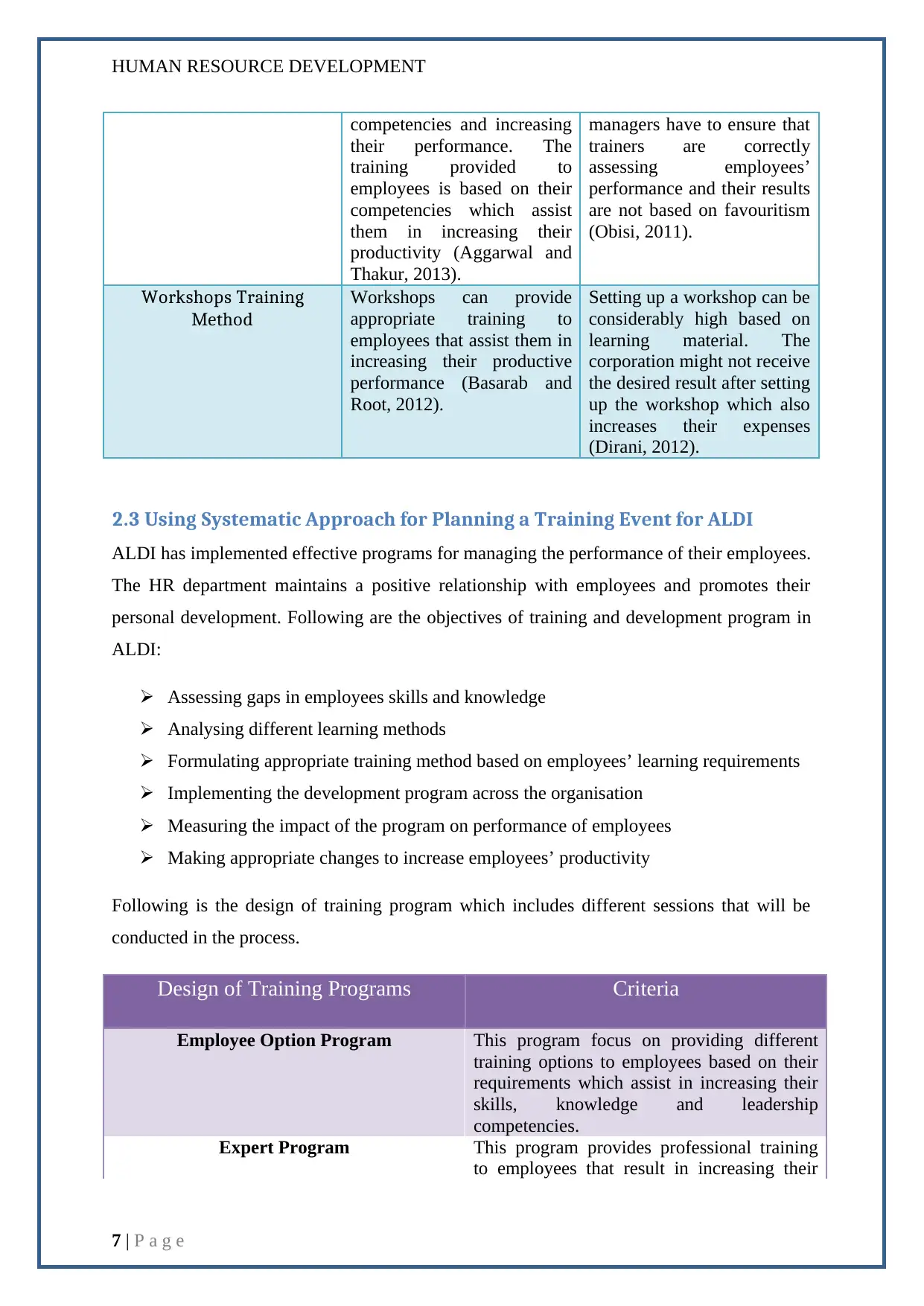
HUMAN RESOURCE DEVELOPMENT
competencies and increasing
their performance. The
training provided to
employees is based on their
competencies which assist
them in increasing their
productivity (Aggarwal and
Thakur, 2013).
managers have to ensure that
trainers are correctly
assessing employees’
performance and their results
are not based on favouritism
(Obisi, 2011).
Workshops Training
Method
Workshops can provide
appropriate training to
employees that assist them in
increasing their productive
performance (Basarab and
Root, 2012).
Setting up a workshop can be
considerably high based on
learning material. The
corporation might not receive
the desired result after setting
up the workshop which also
increases their expenses
(Dirani, 2012).
2.3 Using Systematic Approach for Planning a Training Event for ALDI
ALDI has implemented effective programs for managing the performance of their employees.
The HR department maintains a positive relationship with employees and promotes their
personal development. Following are the objectives of training and development program in
ALDI:
Assessing gaps in employees skills and knowledge
Analysing different learning methods
Formulating appropriate training method based on employees’ learning requirements
Implementing the development program across the organisation
Measuring the impact of the program on performance of employees
Making appropriate changes to increase employees’ productivity
Following is the design of training program which includes different sessions that will be
conducted in the process.
Design of Training Programs Criteria
Employee Option Program This program focus on providing different
training options to employees based on their
requirements which assist in increasing their
skills, knowledge and leadership
competencies.
Expert Program This program provides professional training
to employees that result in increasing their
7 | P a g e
competencies and increasing
their performance. The
training provided to
employees is based on their
competencies which assist
them in increasing their
productivity (Aggarwal and
Thakur, 2013).
managers have to ensure that
trainers are correctly
assessing employees’
performance and their results
are not based on favouritism
(Obisi, 2011).
Workshops Training
Method
Workshops can provide
appropriate training to
employees that assist them in
increasing their productive
performance (Basarab and
Root, 2012).
Setting up a workshop can be
considerably high based on
learning material. The
corporation might not receive
the desired result after setting
up the workshop which also
increases their expenses
(Dirani, 2012).
2.3 Using Systematic Approach for Planning a Training Event for ALDI
ALDI has implemented effective programs for managing the performance of their employees.
The HR department maintains a positive relationship with employees and promotes their
personal development. Following are the objectives of training and development program in
ALDI:
Assessing gaps in employees skills and knowledge
Analysing different learning methods
Formulating appropriate training method based on employees’ learning requirements
Implementing the development program across the organisation
Measuring the impact of the program on performance of employees
Making appropriate changes to increase employees’ productivity
Following is the design of training program which includes different sessions that will be
conducted in the process.
Design of Training Programs Criteria
Employee Option Program This program focus on providing different
training options to employees based on their
requirements which assist in increasing their
skills, knowledge and leadership
competencies.
Expert Program This program provides professional training
to employees that result in increasing their
7 | P a g e
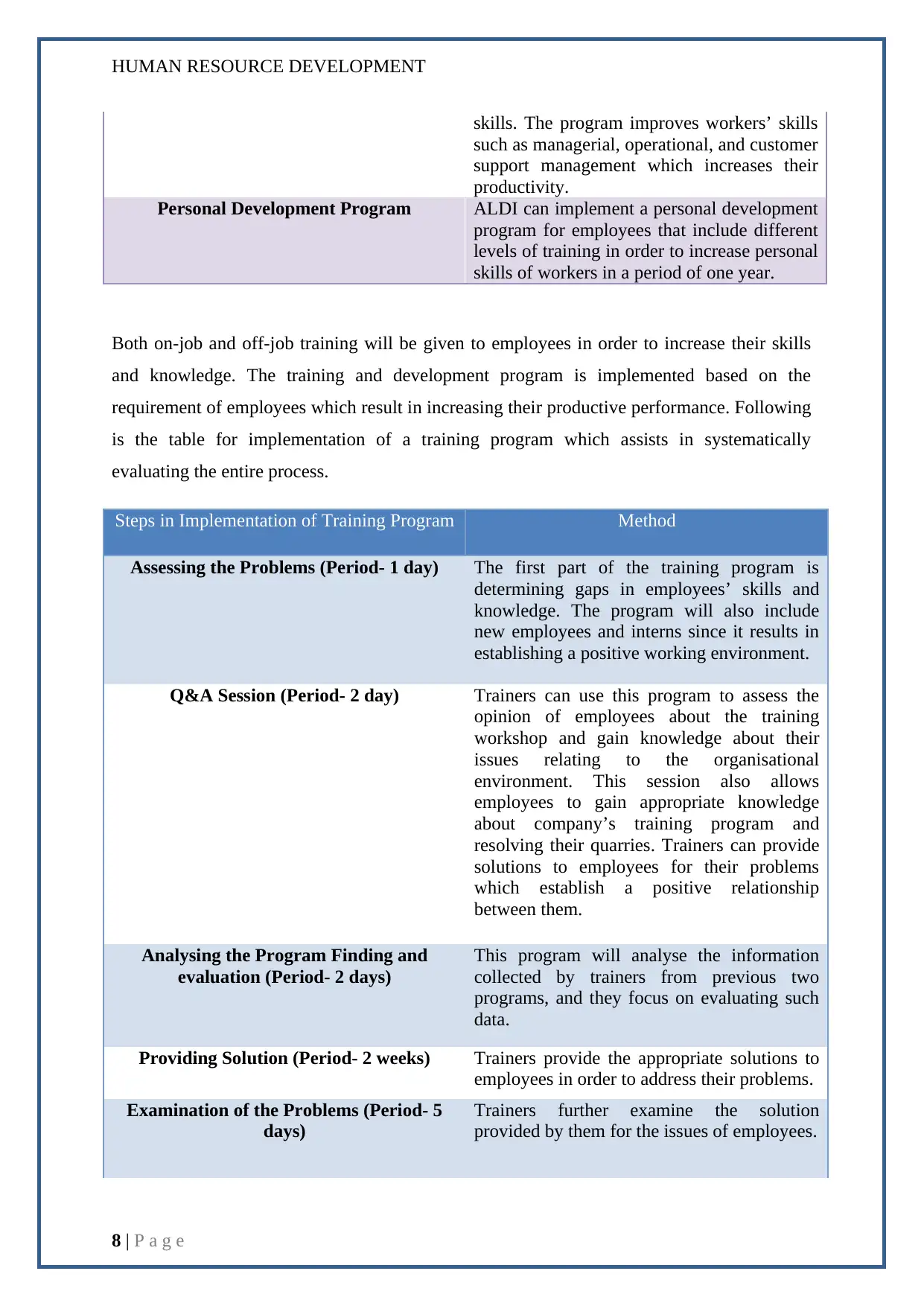
HUMAN RESOURCE DEVELOPMENT
skills. The program improves workers’ skills
such as managerial, operational, and customer
support management which increases their
productivity.
Personal Development Program ALDI can implement a personal development
program for employees that include different
levels of training in order to increase personal
skills of workers in a period of one year.
Both on-job and off-job training will be given to employees in order to increase their skills
and knowledge. The training and development program is implemented based on the
requirement of employees which result in increasing their productive performance. Following
is the table for implementation of a training program which assists in systematically
evaluating the entire process.
Steps in Implementation of Training Program Method
Assessing the Problems (Period- 1 day) The first part of the training program is
determining gaps in employees’ skills and
knowledge. The program will also include
new employees and interns since it results in
establishing a positive working environment.
Q&A Session (Period- 2 day) Trainers can use this program to assess the
opinion of employees about the training
workshop and gain knowledge about their
issues relating to the organisational
environment. This session also allows
employees to gain appropriate knowledge
about company’s training program and
resolving their quarries. Trainers can provide
solutions to employees for their problems
which establish a positive relationship
between them.
Analysing the Program Finding and
evaluation (Period- 2 days)
This program will analyse the information
collected by trainers from previous two
programs, and they focus on evaluating such
data.
Providing Solution (Period- 2 weeks) Trainers provide the appropriate solutions to
employees in order to address their problems.
Examination of the Problems (Period- 5
days)
Trainers further examine the solution
provided by them for the issues of employees.
8 | P a g e
skills. The program improves workers’ skills
such as managerial, operational, and customer
support management which increases their
productivity.
Personal Development Program ALDI can implement a personal development
program for employees that include different
levels of training in order to increase personal
skills of workers in a period of one year.
Both on-job and off-job training will be given to employees in order to increase their skills
and knowledge. The training and development program is implemented based on the
requirement of employees which result in increasing their productive performance. Following
is the table for implementation of a training program which assists in systematically
evaluating the entire process.
Steps in Implementation of Training Program Method
Assessing the Problems (Period- 1 day) The first part of the training program is
determining gaps in employees’ skills and
knowledge. The program will also include
new employees and interns since it results in
establishing a positive working environment.
Q&A Session (Period- 2 day) Trainers can use this program to assess the
opinion of employees about the training
workshop and gain knowledge about their
issues relating to the organisational
environment. This session also allows
employees to gain appropriate knowledge
about company’s training program and
resolving their quarries. Trainers can provide
solutions to employees for their problems
which establish a positive relationship
between them.
Analysing the Program Finding and
evaluation (Period- 2 days)
This program will analyse the information
collected by trainers from previous two
programs, and they focus on evaluating such
data.
Providing Solution (Period- 2 weeks) Trainers provide the appropriate solutions to
employees in order to address their problems.
Examination of the Problems (Period- 5
days)
Trainers further examine the solution
provided by them for the issues of employees.
8 | P a g e
⊘ This is a preview!⊘
Do you want full access?
Subscribe today to unlock all pages.

Trusted by 1+ million students worldwide
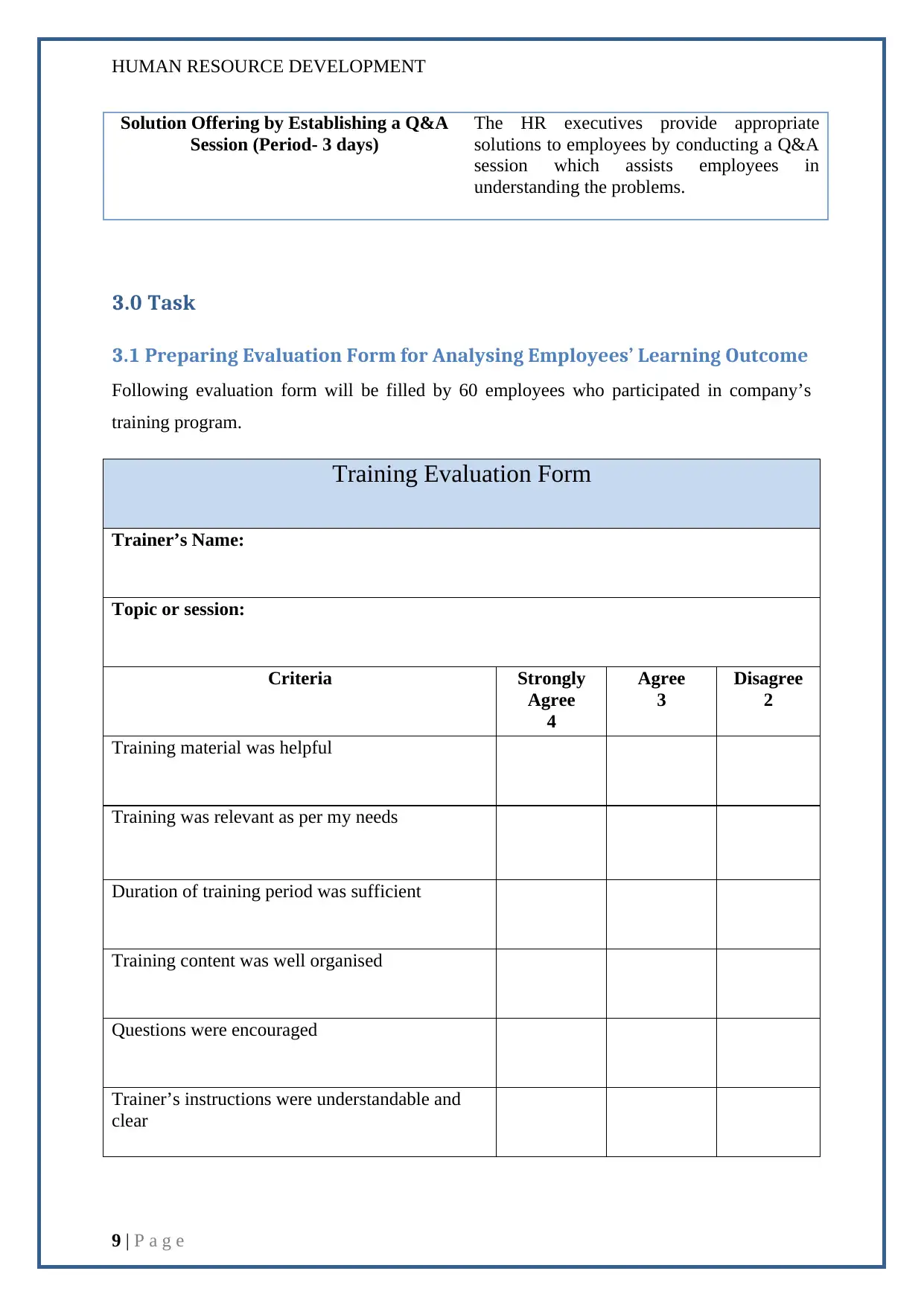
HUMAN RESOURCE DEVELOPMENT
Solution Offering by Establishing a Q&A
Session (Period- 3 days)
The HR executives provide appropriate
solutions to employees by conducting a Q&A
session which assists employees in
understanding the problems.
3.0 Task
3.1 Preparing Evaluation Form for Analysing Employees’ Learning Outcome
Following evaluation form will be filled by 60 employees who participated in company’s
training program.
Training Evaluation Form
Trainer’s Name:
Topic or session:
Criteria Strongly
Agree
4
Agree
3
Disagree
2
Training material was helpful
Training was relevant as per my needs
Duration of training period was sufficient
Training content was well organised
Questions were encouraged
Trainer’s instructions were understandable and
clear
9 | P a g e
Solution Offering by Establishing a Q&A
Session (Period- 3 days)
The HR executives provide appropriate
solutions to employees by conducting a Q&A
session which assists employees in
understanding the problems.
3.0 Task
3.1 Preparing Evaluation Form for Analysing Employees’ Learning Outcome
Following evaluation form will be filled by 60 employees who participated in company’s
training program.
Training Evaluation Form
Trainer’s Name:
Topic or session:
Criteria Strongly
Agree
4
Agree
3
Disagree
2
Training material was helpful
Training was relevant as per my needs
Duration of training period was sufficient
Training content was well organised
Questions were encouraged
Trainer’s instructions were understandable and
clear
9 | P a g e
Paraphrase This Document
Need a fresh take? Get an instant paraphrase of this document with our AI Paraphraser
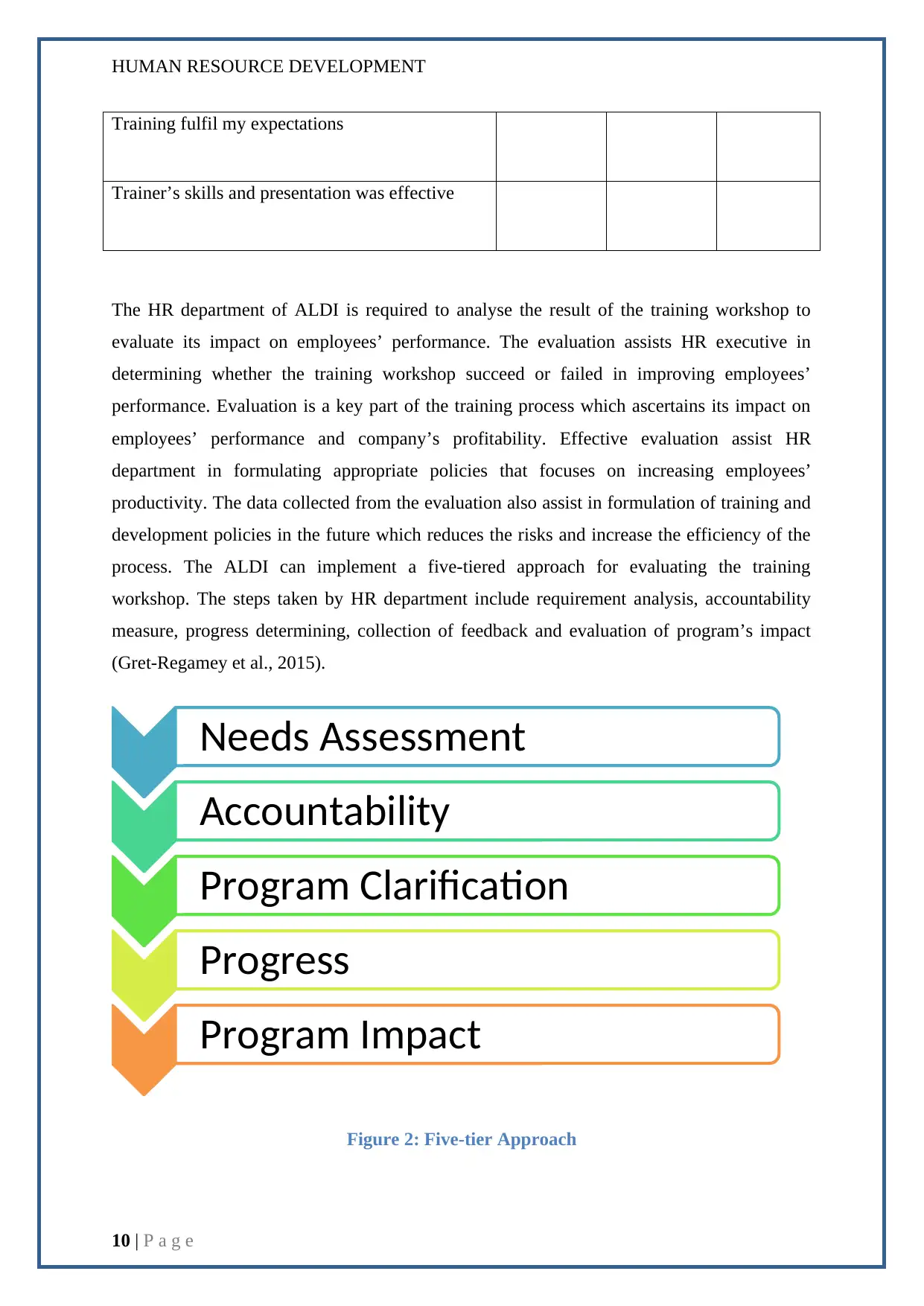
HUMAN RESOURCE DEVELOPMENT
Training fulfil my expectations
Trainer’s skills and presentation was effective
The HR department of ALDI is required to analyse the result of the training workshop to
evaluate its impact on employees’ performance. The evaluation assists HR executive in
determining whether the training workshop succeed or failed in improving employees’
performance. Evaluation is a key part of the training process which ascertains its impact on
employees’ performance and company’s profitability. Effective evaluation assist HR
department in formulating appropriate policies that focuses on increasing employees’
productivity. The data collected from the evaluation also assist in formulation of training and
development policies in the future which reduces the risks and increase the efficiency of the
process. The ALDI can implement a five-tiered approach for evaluating the training
workshop. The steps taken by HR department include requirement analysis, accountability
measure, progress determining, collection of feedback and evaluation of program’s impact
(Gret-Regamey et al., 2015).
Figure 2: Five-tier Approach
10 | P a g e
Needs Assessment
Accountability
Program Clarification
Progress
Program Impact
Training fulfil my expectations
Trainer’s skills and presentation was effective
The HR department of ALDI is required to analyse the result of the training workshop to
evaluate its impact on employees’ performance. The evaluation assists HR executive in
determining whether the training workshop succeed or failed in improving employees’
performance. Evaluation is a key part of the training process which ascertains its impact on
employees’ performance and company’s profitability. Effective evaluation assist HR
department in formulating appropriate policies that focuses on increasing employees’
productivity. The data collected from the evaluation also assist in formulation of training and
development policies in the future which reduces the risks and increase the efficiency of the
process. The ALDI can implement a five-tiered approach for evaluating the training
workshop. The steps taken by HR department include requirement analysis, accountability
measure, progress determining, collection of feedback and evaluation of program’s impact
(Gret-Regamey et al., 2015).
Figure 2: Five-tier Approach
10 | P a g e
Needs Assessment
Accountability
Program Clarification
Progress
Program Impact
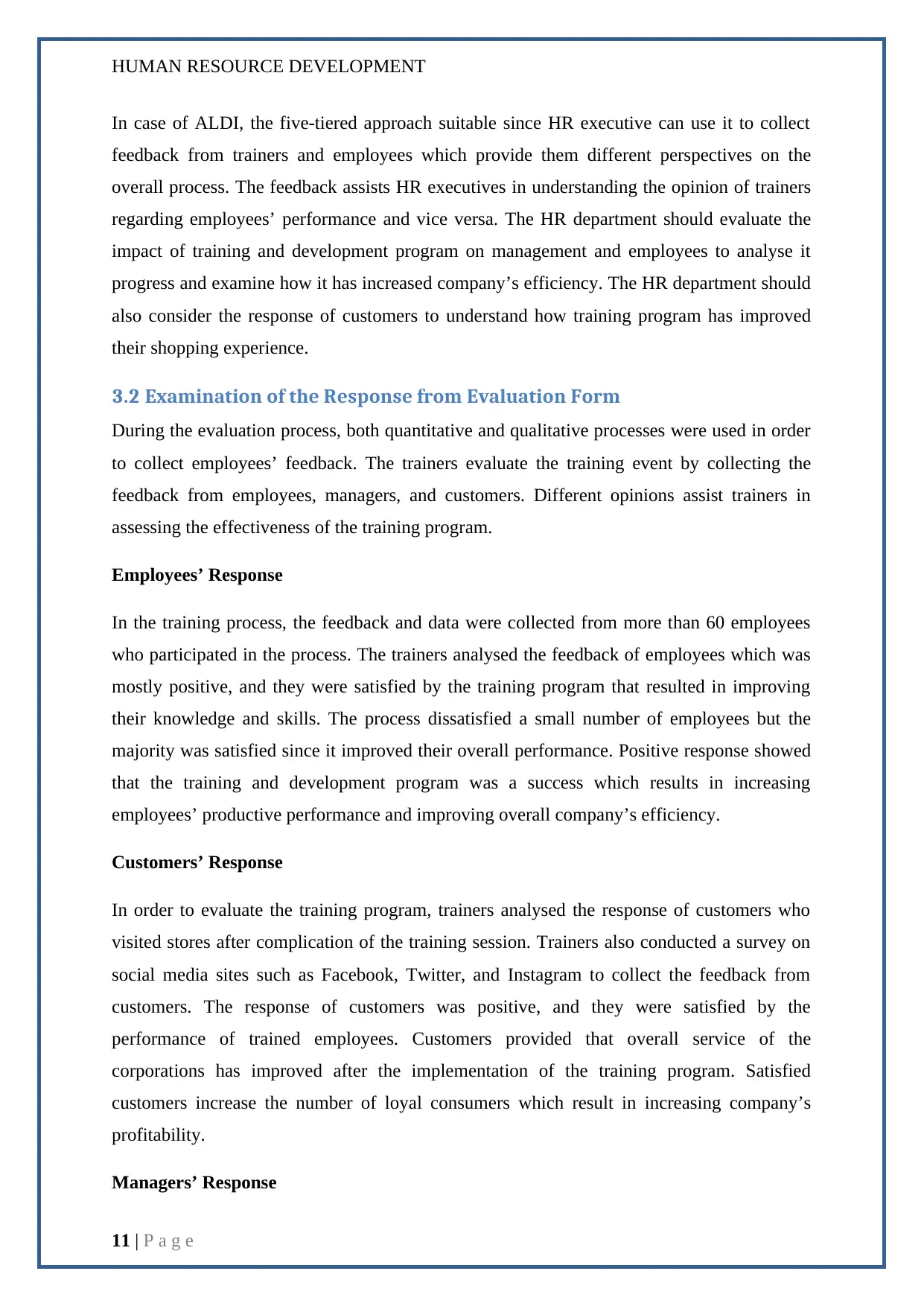
HUMAN RESOURCE DEVELOPMENT
In case of ALDI, the five-tiered approach suitable since HR executive can use it to collect
feedback from trainers and employees which provide them different perspectives on the
overall process. The feedback assists HR executives in understanding the opinion of trainers
regarding employees’ performance and vice versa. The HR department should evaluate the
impact of training and development program on management and employees to analyse it
progress and examine how it has increased company’s efficiency. The HR department should
also consider the response of customers to understand how training program has improved
their shopping experience.
3.2 Examination of the Response from Evaluation Form
During the evaluation process, both quantitative and qualitative processes were used in order
to collect employees’ feedback. The trainers evaluate the training event by collecting the
feedback from employees, managers, and customers. Different opinions assist trainers in
assessing the effectiveness of the training program.
Employees’ Response
In the training process, the feedback and data were collected from more than 60 employees
who participated in the process. The trainers analysed the feedback of employees which was
mostly positive, and they were satisfied by the training program that resulted in improving
their knowledge and skills. The process dissatisfied a small number of employees but the
majority was satisfied since it improved their overall performance. Positive response showed
that the training and development program was a success which results in increasing
employees’ productive performance and improving overall company’s efficiency.
Customers’ Response
In order to evaluate the training program, trainers analysed the response of customers who
visited stores after complication of the training session. Trainers also conducted a survey on
social media sites such as Facebook, Twitter, and Instagram to collect the feedback from
customers. The response of customers was positive, and they were satisfied by the
performance of trained employees. Customers provided that overall service of the
corporations has improved after the implementation of the training program. Satisfied
customers increase the number of loyal consumers which result in increasing company’s
profitability.
Managers’ Response
11 | P a g e
In case of ALDI, the five-tiered approach suitable since HR executive can use it to collect
feedback from trainers and employees which provide them different perspectives on the
overall process. The feedback assists HR executives in understanding the opinion of trainers
regarding employees’ performance and vice versa. The HR department should evaluate the
impact of training and development program on management and employees to analyse it
progress and examine how it has increased company’s efficiency. The HR department should
also consider the response of customers to understand how training program has improved
their shopping experience.
3.2 Examination of the Response from Evaluation Form
During the evaluation process, both quantitative and qualitative processes were used in order
to collect employees’ feedback. The trainers evaluate the training event by collecting the
feedback from employees, managers, and customers. Different opinions assist trainers in
assessing the effectiveness of the training program.
Employees’ Response
In the training process, the feedback and data were collected from more than 60 employees
who participated in the process. The trainers analysed the feedback of employees which was
mostly positive, and they were satisfied by the training program that resulted in improving
their knowledge and skills. The process dissatisfied a small number of employees but the
majority was satisfied since it improved their overall performance. Positive response showed
that the training and development program was a success which results in increasing
employees’ productive performance and improving overall company’s efficiency.
Customers’ Response
In order to evaluate the training program, trainers analysed the response of customers who
visited stores after complication of the training session. Trainers also conducted a survey on
social media sites such as Facebook, Twitter, and Instagram to collect the feedback from
customers. The response of customers was positive, and they were satisfied by the
performance of trained employees. Customers provided that overall service of the
corporations has improved after the implementation of the training program. Satisfied
customers increase the number of loyal consumers which result in increasing company’s
profitability.
Managers’ Response
11 | P a g e
⊘ This is a preview!⊘
Do you want full access?
Subscribe today to unlock all pages.

Trusted by 1+ million students worldwide
1 out of 23
Related Documents
Your All-in-One AI-Powered Toolkit for Academic Success.
+13062052269
info@desklib.com
Available 24*7 on WhatsApp / Email
![[object Object]](/_next/static/media/star-bottom.7253800d.svg)
Unlock your academic potential
Copyright © 2020–2025 A2Z Services. All Rights Reserved. Developed and managed by ZUCOL.




